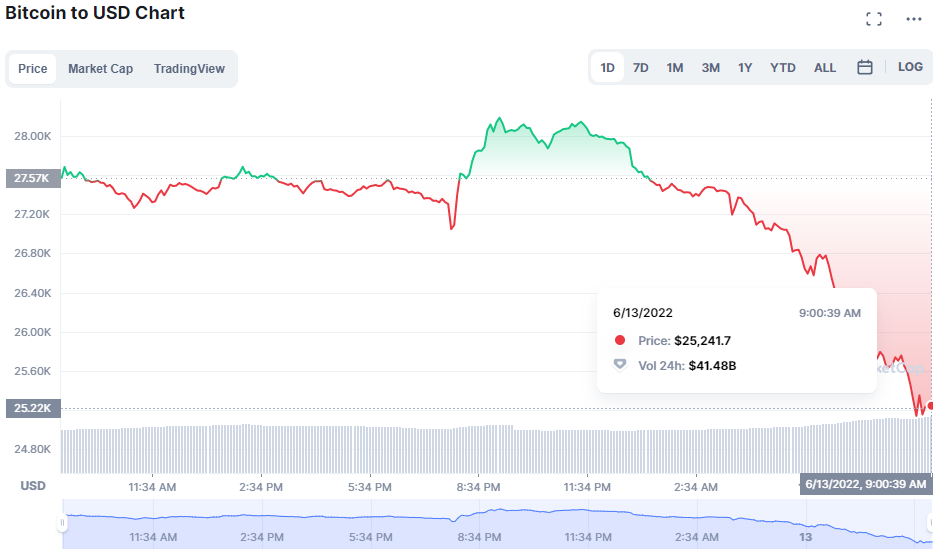The price of Bitcoin fell below $26,000 on Thursday, its lowest dip in over 16 months. This is a part of a recent sell-off in cryptocurrencies that saw over $200 billion disappear from the market in a single day.
Ether, the second most valuable cryptocurrency after Bitcoin, plummeted to $1,704.05, its lowest level since June 2021. The market has been squeezed by recession fears as the price of the two most important and determining cryptocurrencies has dropped, potentially worsening investor emotions.
Experienced investors and experts, on the other hand, are seeing this dip as an opportunity for strategic purchases and portfolio diversification. Looking at prior trends and forecasted market predictions, it appears that the current dip is more likely to be a brief slump than a long-term bear market.
First Look: Understanding the Current Dip
Bitcoin’s price falling below the $26,000 mark reflects the narrow range it is trading within, following the stock and crypto market crash this month. In recent months, the crypto market has been increasingly linked to the stock market, making it even more dependent on global economic variables.
Investors are abandoning cryptocurrencies at a time when stock markets have plummeted in the wake of the coronavirus pandemic due to concerns about growing prices and a poor global economic outlook.
They are also concerned about geopolitical tensions and governments’ tightening monetary policies, particularly the US Federal Reserve.
Inflation figures released by the US government on Wednesday revealed that prices for goods and services rose 8.3% in April, higher than economists had predicted and close to the highest level in 40 years.
The collapse of the stablecoin protocol Terra is also a major concern to investors.
The TerraUSD, or UST, is designed to be a currency that reflects the value of the dollar. Digital asset or crypto investors often turn to “algorithmic” stablecoins like UST for safety during volatile market phases because of the higher regulations and lesser fluctuations.
Despite this, TerraUSD fell below 30 cents on Wednesday, considerably below its $1 peg, as it struggles to maintain a stable value in the face of widespread investor exodus. Investors are also losing faith in the promises of decentralised finance.
Bitcoin Dip and Price Predictions
Expert opinion suggests that this surge does not ensure a long-term reversal, given the cryptocurrency’s history of volatility. The price of bitcoin is just as likely to fall as it is to rise again. Long-term cryptocurrency investors will have to deal with lots more volatility in the future, according to experts.

Many experts are hesitant to estimate a specific amount or a certain date, instead of pointing to the trend of Bitcoin’s value increasing over time. With the $100,000 barrier in sight, investors should expect a sustainable rise in Bitcoin’s long-term value driven by organic market activity.

The most ardent crypto doubters anticipate that Bitcoin will crash to $10,000 by 2022, but a middle ground could be that Bitcoin can still reach $100,000, as many experts projected late last year — albeit on a slower schedule.
As major organisations like Nike and other big brands explore methods to monetise their products in the digital metaverse, bullish analysts are re-evaluating the crypto industry as a whole. The rise of metaverse and NFTs is drawing more investors and more profits in and will lead to a reversal in market situations sooner than later.
Is it Time to Buy the Bitcoin Dip?
The “buy the dip” concept assumes that price dips are only temporary blips that will correct themselves over time. Dip purchasers expect to profit from price drops by purchasing at a discount and reaping the benefits when prices rise again.
If history is any guide, the current Bitcoin dip, or crash as some would call it, could rebound like it did last year, when prices plummeted to comparable lows before rebounding to pre-dip levels and even peaking in the fall.
Some analysts say that dips have always helped crypto investors and that they are excellent entry points for investors to begin developing a strong cryptocurrency portfolio. Just make sure you’re buying certain well-known cryptocurrencies, such as Bitcoin and Ether, when they’re on the decline, for long-term benefits.
Proceed with Caution
The dip and reveals a long-term fact about Bitcoin: it remains a very volatile and speculative asset. In fact, after setting a new high in mid-April, Bitcoin quickly lost over half of its value, plummeting to roughly $30,000 by mid-July 2021. Similarly, Bitcoin fell below $35,000 just a few weeks after reaching a new high in November.
As a result, experts advise limiting your crypto investments to less than 5% of your whole portfolio.
Don’t let a rapid price spike change your long-term investing strategy, just as you shouldn’t let a Bitcoin dip affect your choice to buy crypto.
Even more critical, don’t go out and buy additional cryptocurrency just because the price is going up. Before investing any further funds in a speculative asset like Bitcoin, be sure you have all of your financial bases covered, from retirement accounts to emergency savings.
The best thing you can do is not look at cryptocurrency, regardless of whether it is going up or down. Like any other long-term investing account, you can set it and forget it.
Read More:
Lucky Block – Our Recommended Crypto of 2022
- New Crypto Games Platform
- Featured in Forbes, Nasdaq.com, Yahoo Finance
- LBLOCK Token Up 1000%+ From Presale
- Listed on Pancakeswap, LBank
- Free Tickets to Jackpot Prize Draws for Holders
- Passive Income Rewards – Play to Earn Utility
- 10,000 NFTs Minted in 2022 – Now on NFTLaunchpad.com
- $1 Million NFT Jackpot in May 2022
- Worldwide Decentralized Competitions
Cryptoassets are a highly volatile unregulated investment product. No UK or EU investor protection.
Credit: Source link











































































































































